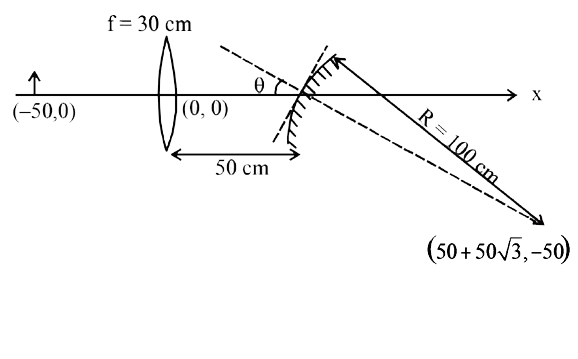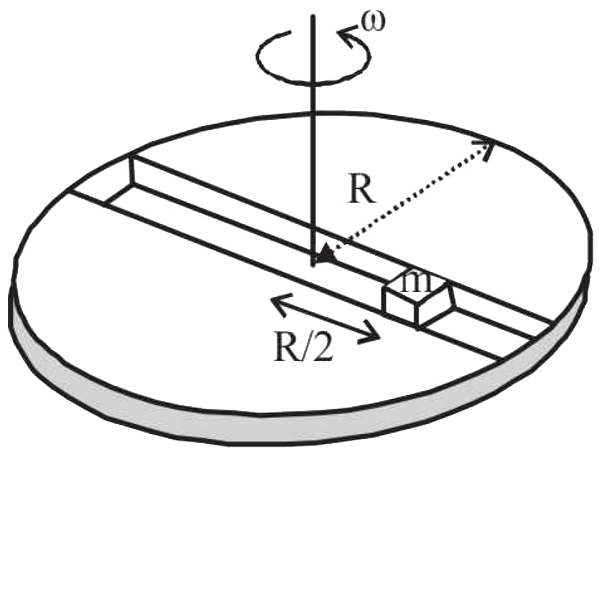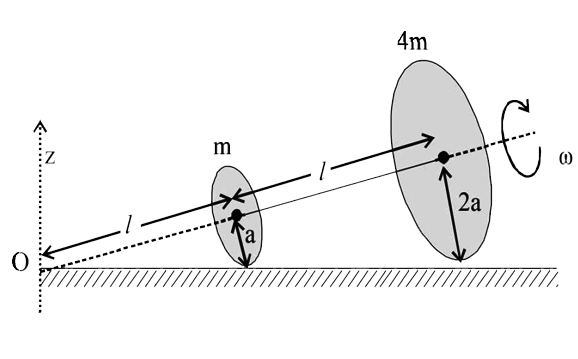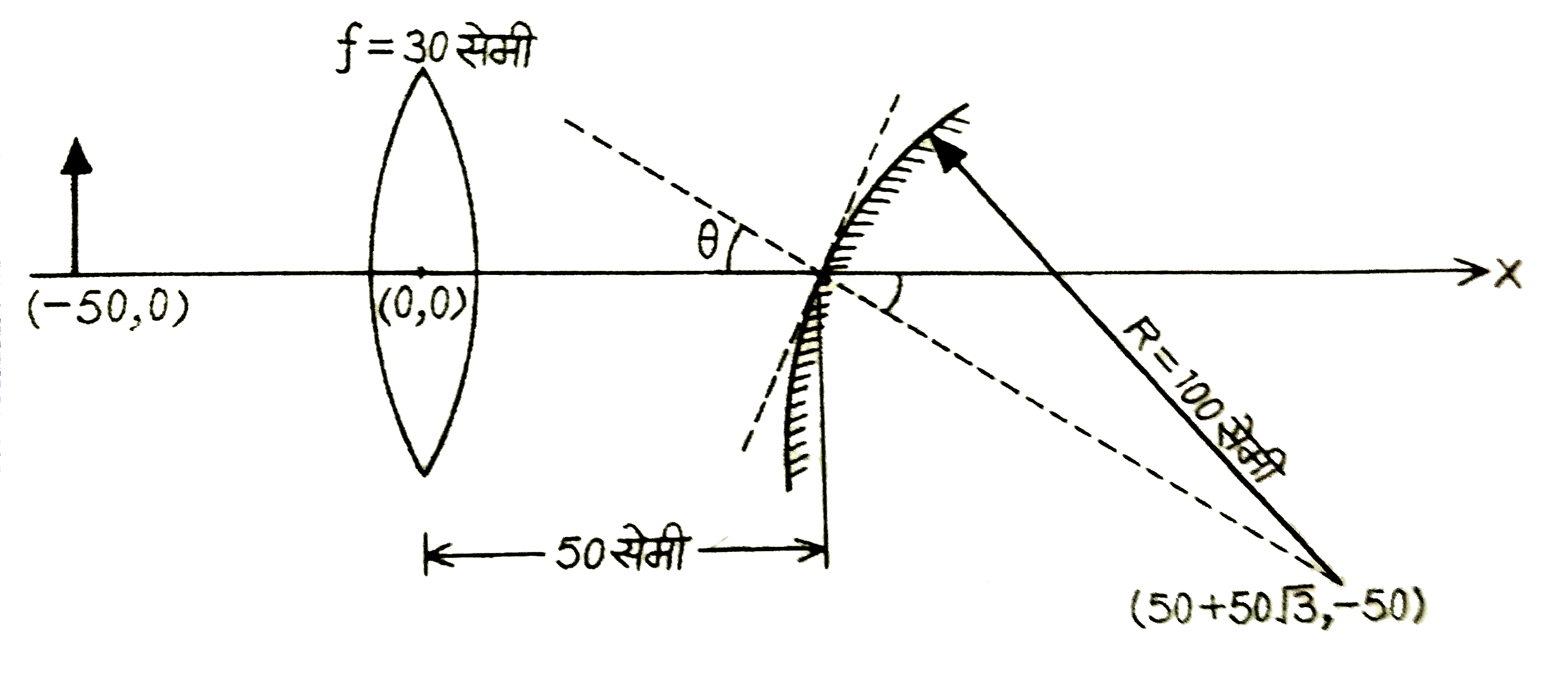A small object is placed 50 cm to the left of a thin convex lens of focal length 30 cm. A convex spherical mirror of radius of curvature 100 cm is placed to the right of the lens at a distance of 50 cm. The mirror is tilted such that the axis of the mirror is at an angle θ=30degree to the axis of the lens, as shown in the figure
If the origin of the coordinate system is taken to be at the centre of the lens, the coordinates (in cm) of the point (x,y) at which the image is formed are

(0,0)
(50−25√3,25)
(25,25√3)
(125/3,25/√3)
The correct Answer is:C
Step by step video & image solution for A small object is placed 50 cm to the left of a thin convex lens of focal length 30 cm. A convex spherical mirror of radius of curvature 100 cm is placed to the right of the lens at a distance of 50 cm. The mirror is tilted such that the axis of the mirror is at an angle theta=30degree to the axis of the lens, as shown in the figure If the origin of the coordinate system is taken to be at the centre of the lens, the coordinates (in cm) of the point (x,y) at which the image is formed are by Physics experts to help you in doubts & scoring excellent marks in Class 12 exams.
Topper's Solved these Questions
- BOOK - JEE ADVANCED PREVIOUS YEARCHAPTER - JEE ADVANCEDEXERCISE - PART I : PHYSICS (SECTION 3)2videos
JEE ADVANCED
- BOOK - JEE ADVANCED PREVIOUS YEARCHAPTER - JEE ADVANCEDEXERCISE - Part I : PHYSICS (Section 2)13videos
JEE ADVANCED
- BOOK - JEE ADVANCED PREVIOUS YEARCHAPTER - JEE ADVANCEDEXERCISE - PART-1 PHYSICS (SECTION 3 )5videos
JEE ADVANCED
- BOOK - JEE ADVANCED PREVIOUS YEARCHAPTER - JEE (ADVANCE) 2020EXERCISE - SECTION 36videos
JEE (ADVANCE) 2020
- BOOK - JEE ADVANCED PREVIOUS YEARCHAPTER - JEE ADVANCED 2020EXERCISE - SECTION-36videos
JEE ADVANCED 2020
Similar Questions
A frame of reference that is accelerated with respect to an inertial frame of reference is called a non-inertial frame of reference. A coordinate system fixed on a circular disc rotating about a fixed axis with a constant angular velocity ω is an example of non=inertial frame of reference. The relationship between the force →Frot experienced by a particle of mass m moving on the rotating disc and the force →F∈ experienced by the particle in an inertial frame of reference is
→Frot=→Fin+2m(→vrot×→ω)+m(→ω×→r)×→ω.
where →vrot is the velocity of the particle in the rotating frame of reference and →r is the position vector of the particle with respect to the centre of the disc.
Now consider a smooth slot along a diameter fo a disc of radius R rotating counter-clockwise with a constant angular speed ω about its vertical axis through its center. We assign a coordinate system with the origin at the center of the disc, the x-axis along the slot, the y-axis perpendicular to the slot and the z-axis along the rotation axis (→ω=ωˆk). A small block of mass m is gently placed in the slot at →r(R/2)ˆi at t=0 and is constrained to move only along the slot.

The distance r of the block at time is05:51View SolutionTwo thin circular discs of mass m and 4m, having radii of a and 2a, respectively, are rigidly fixed by a massless, rigid rod of length l=√24a through their centres. This assembly is laid on a firm and flat surface, and set rolling without slipping on the surface so that the angular speed about the axis of the rod is ω. The angular momemtum of the entire assembly about the point 'O' is vacL (see the figure). Which of the follwing statement (s) is (are) true?
 04:41View Solution
04:41View SolutionA metal is heated in a furnace where a sensor is kept above the metal surface to read the power radiated (P) by the metal. The sensor has scale that displays log2,(P/P0), where P0 is constant. When the metal surface is at a temperature of 487∘C, the sensor shows a value 1. Assume that the emissivity of the metallic surface remains constant. What is the value displayed by the sensor when the temperature of the metal surface is raised to 2767∘C?
03:54View SolutionA spherical bubbles inside water has radius R . Take the pressuere in the bubbled and the water pressure to be pv. The bubble now gets compressed radially in an adiabatic manner so that its raduis becomes (R - a) . For a<<R the magnitude of the work done in the process is given by (4πpoRa2)X. where X is a a constant and y=Cp/Cv=41/30. The value of X is
04:49View SolutionPut a unifrom meter scale horizontally on your extended index fingers with the left one at 0.0 cm and the right one at 90.00 cm when you attempt to move both the fingers slowly towards the center , initially only the left finger slips with respect to to the scale and the right finger does not . after some distance, the left finger stops and the right one starts slipping . Then the right finger stops at a distance XR from the center (50.00 cm ) of the scale and the left one starts slopping again . This happens because to the difference in the fiictional forces on the two fingers . it the coefficients of static and dynamic between the fingers and the scale are 0.4 and 0.32 respectively , the value of XR (in cm is ...........
03:28View SolutionA small object is placed 50 cm to the left of a thin convex lens of focal length 30 cm. A convex spherical mirror of radius of curvature 100 cm is placed to the right of the lens at a distance of 50 cm. The mirror is tilted such that the axis of the mirror is at an angle theta =30degree to the axis of the lens, as shown in the figure If the origin of the coordinate system is taken to be at the centre of the lens, the coordinates (in cm) of the point (x,y) at which the image is formed are
03:57View SolutionAn optical system consists of a thin convex lens of focal length 30 cm and a plane mirror placed 15 cm behind the lens. An object is placed 15 cm in front of the lens. The distance of the final image from the object is
06:21View SolutionA convex lens and a convex mirror of radius of curvature 20cm are placed co-axially with the convex mirror placed at a distance of 30cm from the lens. For a point object at a distance of 25cm from the lens, the final image due to this combination coincides with the object itself. What is the focal length of convex lens ?
08:17View SolutionA convex lens of focal length 15cm is placed in front of a convex mirror. Both are coaxial and the lens is 5cm from the apex of the mirror. When an object is placed on the axis at a distance of 20cm from the lens, its is found that image coincides with the object. Calculate the radius of curvature of mirror.
[55cm]05:47View SolutionA convex lens of focal length 15 cm is placed on a plane mirror. An object is placed at 30 cm from the lens. The image is
View SolutionA convex lens and a convex mirror are separated by a distance of 10 cm such that the reflecting surface of the mirror faces the lens. The image of an object placed in front of the convex. Lens at a distance of 20 cm is found to coincide with the object. If the focal length of the convex lens is 15 cm, determine the focal length of the mierror.
07:11View Solution15 सेमी फोकस-दूरी वाला एक द्वि-उत्तल लेन्स समतल दर्पण के सामने रखा है | लेन्स तथा दर्पण की बीच दूरी 10 सेमी है | लेन्स से 30 सेमी की दूरी पर एक छोटी वस्तु रखी गयी है | इसका अंतिम प्रतिबिम्ब :
04:06View Solutionएक छोटी वस्तु को 30 सेमी फोकस दुरी वाले एक पतले उत्तल लेन्स की बायीं ओर 50 सेमी की दूरी पर रखा गया है | 100 सेमी की वक्रता त्रिज्या वाले एक उत्तल गोलाकार दर्पण को लेन्स के दायीं ओर 50 सेमी की दूरी पर रखा गया है | दर्पण को इस प्रकार से झुकाया गया है कि दर्पण की अक्ष लेन्स की अक्ष से θ=30∘ का कोण बनती है, जैसा चित्र में दर्शाया गया है

यदि निर्देशांक पद्धति का मूल बिंदु लेन्स के मध्य में हो, तो जहाँ प्रतिबिम्ब बना है उस बिंदु का निर्देशांक (x,y) सेमी में है :04:43View Solution+4D क्षमता वाले उत्तल लेंस के बायी ओर उससे 30 सेमी की दूरी पर एक बिन्दु वस्तु O रखी है। जब इस लेंस से 50 सेमी की दूरी पर एक उत्तल दर्पण रख दिया जाता है। तो लेंस - दर्पण के इस संयोजन द्वारा बना वस्तु का प्रतिबिंब वस्तु O पर ही बनता है। उत्तल दर्पण की फोकस दूरी ज्ञात कीजिए।
04:08View SolutionA point object O is kept at a distance of 30 cm from a convex lens of power + 4D towards its left. It is observed that when a convex mirror is kept on right side at 50 cm from the lens, the image of object O formed by lens-mirror combination coincides with object itself. Calculate focal length of mirror
View SolutionA concave mirror of focal length 20 cm and a convex lens of focal length 10 cm are kept with their optic axes parallel but separated by 0.5 mm as shown in the figure. The distance between the the lens and mirror in 10 cm. An object of height 3 mm is placed on the optic axis of lens at a distance between the lens and mirror is 10 cm. An object of height 3 mm is placed on the optic axis of lens at a distance 15 cm from the lens. Find the length of the image formed the mirror in mm.
06:23View Solution

